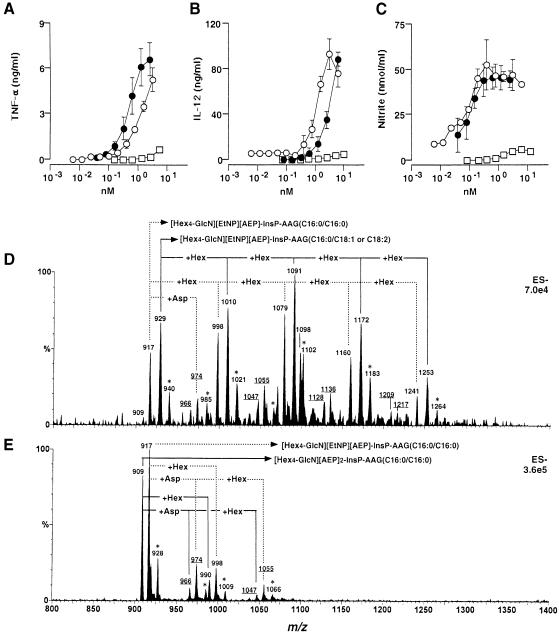Fig. 2. Bioactivity and mass spectra of purified GPI anchors released from T.cruzi mucins. Samples were presented to 106 thioglycollate-elicited, IFN–γ-primed, murine peritoneal macrophages and titrations of the TNF–α- (A), IL–12(p40)- (B) and NO- (C) inducing activities of intact trypomastigote mucin (•), purified GPI released from trypomastigote mucin (○) and purified GPI released from epimastigote mucin (□) are shown. The data shown in (A–C) are representative of four separate titration experiments. Each cytokine and NO determination was carried out in duplicate, and the error bars (where visible) indicate the standard error of the mean. The purified trypomastigote GPI (D) and epimastigote GPI (E) fractions were analysed by negative-ion ES–MS. The compositions corresponding to each [M–2H]2– pseudomolecular ion are indicated. Ions marked with asterisks are [M+Na–3H]2– pseudomolecular ions, and the underlined ions correspond to GPI anchors attached to Asp. EtNP, ethanolamine phosphate; AEP, 2–aminoethylphosphonate; InsP, inositol-phosphate; AAG, alkylacylglycerol. The numbers following the AAG abbreviation correspond to the chain length and degree of unsaturation of the alkyl/acyl chains. Note: m/z differences of 81 correspond to mass differences of 162 [equivalent to a hexose (Hex), i.e. mannose or galactose] because the charge state of the ions (z) is 2.

An official website of the United States government
Here's how you know
Official websites use .gov
A
.gov website belongs to an official
government organization in the United States.
Secure .gov websites use HTTPS
A lock (
) or https:// means you've safely
connected to the .gov website. Share sensitive
information only on official, secure websites.
